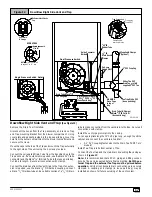
10
440 01 2020 01
4. Vent and Combustion Air Piping
CARBON MONOXIDE POISONING, FIRE AND EXPLO-
SION HAZARD.
Failure to properly vent this furnace can result in death,
personal injury and/or property damage.
Read and follow all instructions in this section.
!
Dual Certified (*9MPT & *9MPV Models)
This furnace is certified as a category
IV
appliance. This furnace
can be installed as a direct vent furnace using outside air for com-
bustion or the furnace can use air from inside the structure for com-
bustion. The
INLET
air pipe is optional. If combustion air comes
from inside the structure, adequate make up air
MUST
be provided
to compensate for oxygen burned. See
Confined Space Installa-
tion
in the
Combustion and Ventilation Air
chapter. If combus-
tion air is drawn from outside the structure, it
MUST
be taken from
the same atmospheric pressure zone as the vent pipe.
Contaminated Combustion Air
Installations in certain areas or types of structures will increase the
exposure to chemicals or halogens that may harm the furnace.
The following areas or types of structures may contain or have ex-
posure to the substances listed below. The installation must be
evaluated carefully as it may be necessary to provide outside air for
combustion.
·
Commercial buildings.
·
Buildings with indoor pools.
·
Furnaces installed in laundry rooms.
·
Furnaces installed in hobby or craft rooms.
·
Furnaces installed near chemical storage areas.
·
Permanent wave solutions for hair.
·
Chlorinated waxes and cleaners.
·
Chlorine based swimming pool chemicals.
·
Water softening chemicals.
·
De--icing salts or chemicals.
·
Carbon tetrachloride.
·
Halogen type refrigerants.
·
Cleaning solvents (such as perchloroethylene).
·
Printing inks, paint removers, varnishes, etc.
·
Hydrochloric acid.
·
Sulfuric Acid.
·
Solvent cements and glues
.
·
Antistatic fabric softeners for clothes dryers.
·
Masonry acid washing materials.
Vent and Combustion Air Piping Guidelines
NOTE:
All vent piping
MUS
T be installed in compliance with local
codes or ordinances, these instructions, good trade practices, and
codes of country having jurisdiction.
1. Determine the best routing and termination for the vent pipe
and air inlet pipe by referring to all of the instructions and
guidelines in this Section.
2. Determine the size required for the vent pipe and air inlet
pipe.
3. Loosely assemble all venting parts without adhesive (pipe
joint cement) for correct fit before final assembly.
4. Use of vertical piping is preferred because there will be
some moisture in the flue gases that may condense as it
leaves the vent pipe (See
Special Instruction For Horizontal
Vents
).
5. The vertical vent pipe
MUST
be supported so that no weight
is allowed to rest on the combustion blower.
6. Exhaust vent piping or air inlet piping diameter
MUST NOT
be reduced.
7. All exhaust vent piping from the furnace to termination
MUST
slope upwards. A minimum of
1
/
4
²
per foot of run is
required to properly return condensate to the furnace drain
system.
8. Use DWV type long radius elbows whenever possible, as
they provide for the minimum slope on horizontal runs and
they provide less resistance in the vent system. If DWV el-
bows cannot be used, use two, 45
°
elbows when possible.
On horizontal runs the elbows can be slightly misaligned to
provide the correct slope.
9. All horizontal pipe runs
MUST
be supported at least every
five feet with galvanized strap or other rust resistant materi-
al.
NO
sags or dips are permitted.
10. All vertical pipe runs
MUST
be supported every six feet
where accessible.
11. The maximum pipe length is 40
¢
total in the inlet
or
outlet
side of the system. Up to five, 90
°
elbows can be used on the
inlet
or
the outlet. With the Concentric Vent Termination Kits
(NAHA001CV or NAHA002CV), the maximum pipe length is
35
¢
with 4 90
°
elbows. If more elbows are required, reduce
the length of both the inlet and exhaust pipes 5
¢
for each
additional elbow used. (See
Table 3
or
Table 4).
12. The minimum pipe run length is 2
¢
.
13. The piping can be run in the same chase or adjacent to sup-
ply or vent pipe for water supply or waste plumbing. It can
also be run in the same chase with a vent from another 90+
furnace.
NOTE
: In
NO
case can the piping be run in a chase where
temperatures can exceed 140
°
F. or where radiated heat
from adjacent surfaces would exceed 140
°
F.
14. The vent outlet
MUST
be installed to terminate in the same
atmospheric pressure zone as the combustion air inlet.
15. The vent system can be installed in an existing unused chim-
ney provided that:
·
Both the exhaust vent and air intake run the length of the
chimney.
·
No other gas fired appliance or fireplace (solid fuel) is
vented into the chimney.
·
The top of the chimney
MUST
be sealed flush or crowned
up to seal against rain or melting snow so
ONLY
the piping
protrudes.
·
The termination clearances shown in
Figure 7
are main-
tained.
16. Furnace applications with vertical vents requiring vent diam-
eter increaser fittings
must
have increaser fittings installed
in vertical portion of the vent. Condensate will be trapped in
the vent if the vent diameter is increased prior to having an
elbow turned upward. This could cause nuisance tripping of
the pressure switch.
Summary of Contents for 9MPT050F12A
Page 46: ...46 440 01 2020 01...











































